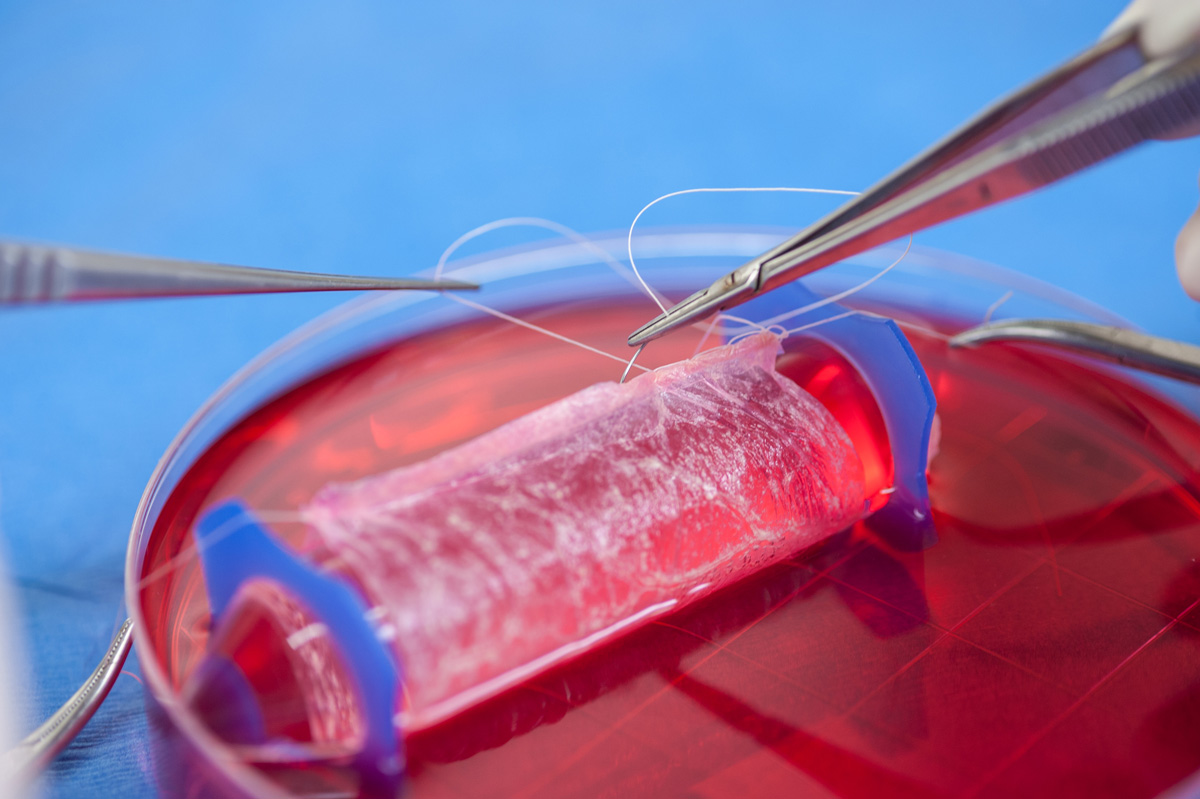Laboratory-grown vaginas implanted in patients
April 14, 2014

The scaffold is configured into a vaginal shape (credit: Wake Forest Baptist Medical Center’s Institute for Regenerative Medicine)
A research team led by Anthony Atala, M.D., director of Wake Forest Baptist Medical Center’s Institute for Regenerative Medicine, has reported in The Lancet the first human recipients of laboratory-grown vaginal organs, which were engineered with their own cells.
“This pilot study is the first to demonstrate that vaginal organs can be constructed in the lab and used successfully in humans,” said Atala. “This may represent a new option for patients who require vaginal reconstructive surgeries.”
The teenage girls in the study were born with Mayer-Rokitansky-Küster-Hauser (MRKH) syndrome, a rare genetic condition in which the vagina and uterus are underdeveloped or absent. The treatment could also potentially be applied to patients with vaginal cancer or injuries, according to the researchers.
The girls were between 13 and 18 years old at the time of the surgeries, which were performed between June 2005 and October 2008. Data from annual follow-up visits show that even up to eight years after the surgeries, the organs had normal function.
“Tissue biopsies, MRI scans and internal exams using magnification all showed that the engineered vaginas were similar in makeup and function to native tissue, said Atlantida-Raya Rivera, lead author and director of the HIMFG Tissue Engineering Laboratory at the Metropolitan Autonomous University in Mexico City, where the surgeries were performed.
In addition, the patients’ responses to a Female Sexual Function Index questionnaire showed they had normal sexual function after the treatment, including desire and pain-free intercourse.
The organ structures were engineered using muscle and epithelial cells (the cells that line the body’s cavities) from a small biopsy of each patient’s external genitals. In a Good Manufacturing Practices facility, the cells were extracted from the tissues, expanded and then placed on a biodegradable material that was hand-sewn into a vagina-like shape. These scaffolds were tailor-made to fit each patient.
About five to six weeks after the biopsy, surgeons created a canal in the patient’s pelvis and sutured the scaffold to reproductive structures. Previous laboratory and clinical research in Atala’s lab has shown that once cell-seeded scaffolds are implanted in the body, nerves and blood vessels form and the cells expand and form tissue. At the same time the scaffolding material is being absorbed by the body, the cells lay down materials to form a permanent support structure, gradually replacing the engineered scaffold with a new organ.
Researchers at Children’s Hospital Mexico Federico Gomez Metropolitan Autonomous University, Mexico were also involved in the study, which was funded by Wake Forest University and Hospital Infantil de México Federico Gómez.
Abstract of The Lancet paper
Background – Several disorders might require vaginal reconstruction, such as congenital abnormalities, injury, or cancer. Reconstructive techniques for which non-vaginal tissue is used can be associated with complications. We assessed the use of engineered vaginal organs in four patients with vaginal aplasia caused by Mayer-Rokitansky-Küster-Hauser syndrome (MRKHS).
Methods – We invited to participate four consecutive patients who presented over a 3-year period with congenital vaginal aplasia due to MRKHS. Patients were aged 13-18 years. We obtained a vulvar biopsy of autologous tissue from every patient. We cultured, expanded, and seeded epithelial and muscle cells onto biodegradable scaffolds. The organs were constructed and allowed to mature in an incubator in a facility approved for human-tissue manufacturing. We used a perineal approach to surgically implant these organs. We recorded history, physical examination, vaginoscopy, serial tissue biopsies, MRIs, and self-administered Female Sexual Function Index questionnaire results for all patients, with a follow-up of up to 8 years.
Findings – We noted no long-term postoperative surgical complications. Yearly serial biopsies showed a tri-layered structure, consisting of an epithelial cell-lined lumen surrounded by matrix and muscle, with expected components of vaginal tissue present. Immunohistochemical analysis confirmed the presence of phenotypically normal smooth muscle and epithelia. The MRIs, which showed the extent of the vaginal aplasia before surgery, showed the engineered organs and the absence of abnormalities after surgery, which was confirmed with yearly vaginoscopy. A validated self-administered Female Sexual Function Index questionnaire showed variables in the normal range in all areas tested, such as desire, arousal, lubrication, orgasm, satisfaction, and painless intercourse.
Interpretation – Vaginal organs, engineered from the patient’s own cells and implanted, showed normal structural and functional variables with a follow-up of up to 8 years. These technologies could be useful in patients requiring vaginal reconstruction.
Funding – Wake Forest University and Hospital Infantil de México Federico Gómez.